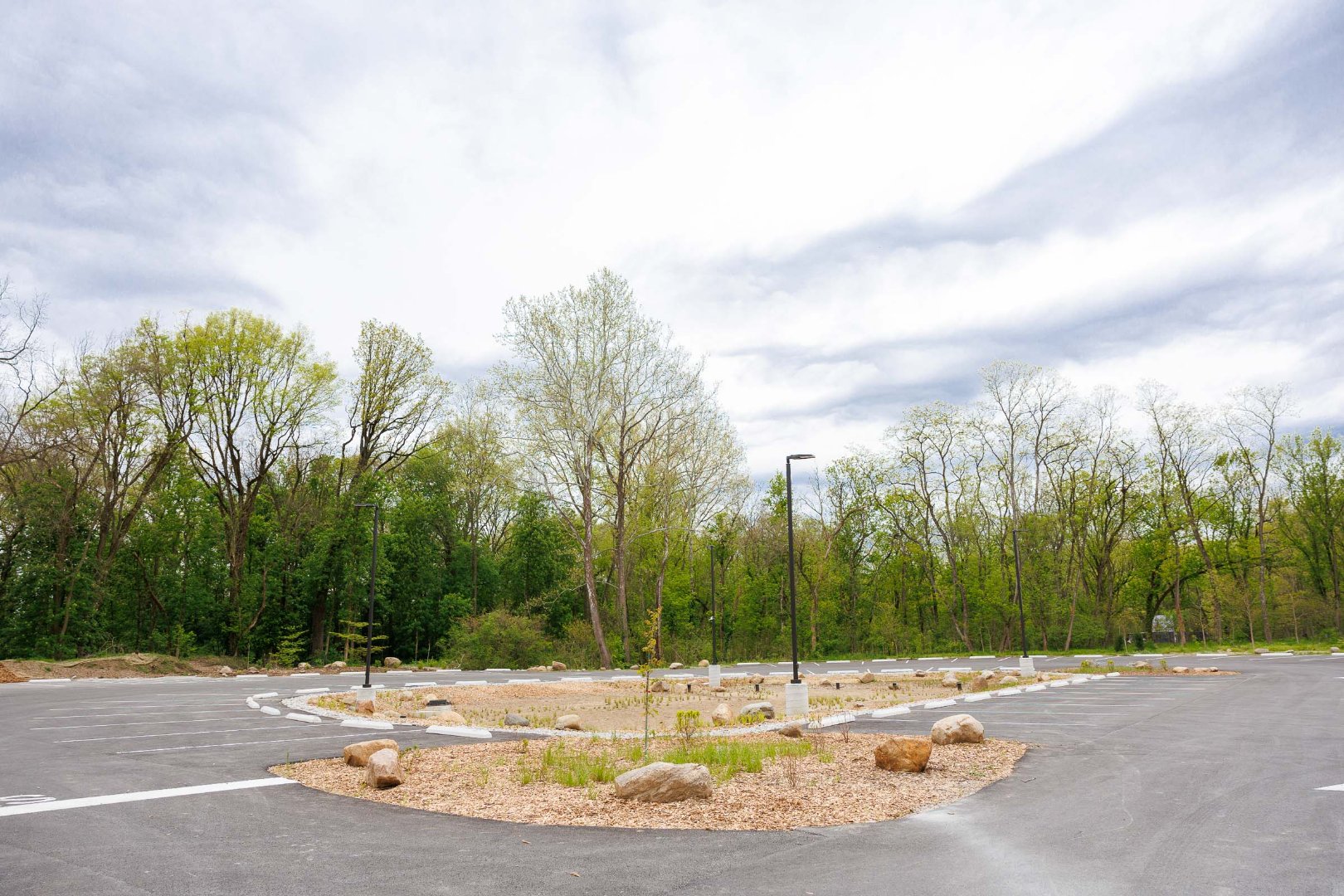Campus-Wide Sustainable Development: Newfields is committed to creating and maintaining built environments that are aligned with the management of natural resources across campus. This includes approaching any new construction project with an environmental lens, such as through the living building challenge. It also means utilizing conscious environmental design in renovations of existing structures as resources allow. We consider the environment during each phase: design, contracting, construction, and even a product’s end of life.
Did you know? Newfields boasts the largest intensive green roof in Indiana. Sutphin Mall sits atop the parking garage and creates more green space and absorption of rainwater.
The Ruth Lilly Visitors Pavilion: On June 20, 2010, the Ruth Lilly Visitors Pavilion opened in The Virginia B. Fairbanks Art & Nature Park with LEED (Leadership in Energy and Environmental Design) certification. The 3,000-square-foot structure is both aesthetically innovative and functional, providing visitors with restrooms, emergency phones, and shelter. Designed by Marlon Blackwell Architects, the Visitors Pavilion serves as a cornerstone of Fairbanks Park. The building and all light fixtures in The Park also participate in Lights Out Indy for the protection of birds and insects.

The form of the building takes inspiration from the structure and geometry of a fallen, folded leaf. The large angular deck folds back on itself to form the canopy above, both of which are constructed to allow for the free flow of sunlight and rainwater, and the unique visible steel structure of the building is reminiscent of the leaf's skeletal veins.

The interior space is surrounded by glass on three sides in addition to the skylight ceiling above, allowing visitors to maintain a powerful connection to the natural world around them. The building provides a versatile gathering and education space and accessible restrooms.
It is constructed with certified plantation-grown tropical hardwoods and utilizes geothermal heating and cooling systems. Fallen logs integral to the ecosystem were temporarily removed for construction and then returned to preserve the site’s ecological balance. Tension, rather than compression, was used to hold the suspended canopy, reducing the impact to soils within the building’s footprint.
Thoughtful and careful attention was paid to environmental sensitivity and energy efficiency throughout the design and construction process. Water-saving fixtures fed by on-site well water, energy-efficient lighting and geothermal heating and cooling reduce energy and consumption of daily operations. Simple markings have been added to the glass to reduce the probability of bird strikes. The building is conscientiously designed to inhabit the unique floodplain environment, allowing for the free flow of occasional floodwaters around and beneath the structure.
The American Institute of Architects (AIA) recognized Marlon Blackwell and the Pavilion with a 2012 Honor Award, the AIA's highest prize. At the time of the award, this was the first Indiana project to receive this honor in 30 years.

Rain Gardens: A sustainable, natural solution to a common problem in urban areas, rain gardens capture and filter storm water runoff from hard surfaces that would otherwise flow into nearby waterways, often carrying petroleum products and other pollutants.
Fairbanks Park utilizes rain gardens in both parking lots and along the Fehnel Entrance ramp. The original parking lot for The Park features an abundance of native plants which are watered by storm drains that flow under the sidewalks and through a series of check dams, which slow flow and keep water onsite to be used by the plants. The Fehnel Entrance features cutouts in the curb along the sidewalk at each of the ramp’s switchbacks. This funnels water into a series of pools to the west side of the ramp and toward The Park’s forested wetland on the east side of the ramp.
These designs utilize drought and flood tolerant native plants to promote groundwater recharge and evapotranspiration, two natural processes that reduce the impact of rain events on the adjacent White River. These plants also have the ability to clean stormwater through a series of biological processes and promote healthy soils which do the same.

These rain gardens also provide aesthetic and educational benefits. In 2024, Newfields added 82 additional parking spaces to increase access to The Virginia B. Fairbanks Art & Nature Park with the support of the Richard M. Fairbanks Foundation. The parking lot was designed as a bowl which drains entirely into a central, over-sized bioretention basin which keeps 100% of stormwater onsite with a zero impact to the adjacent White River. The basin was planted as a new rain garden, the Bioretention Rain Garden, made possible by The Indianapolis Garden Club.
The overall design of the parking lot, Bioretention Rain Garden, and surrounding garden spaces provide ecosystem services, support local wildlife, improve the park’s biodiversity, and promote the use of native plants and green infrastructure. Newfields received an award for the project from the White River Alliance for Exceptional Commitment to Watershed Protection due to a demonstrated commitment to water conservation and waste reduction at all stages of the project.
Green Roof: Newfields has the largest intensive green roof in the city over top of the parking garage. This greenspace reduces the heat buildup that a typical parking lot would generate. It also allows the rainwater to infiltrate into the soil rather than run off into our storm drains. This keeps water onsite to filter back into the aquifer, rather than contributing to high velocity flows in the White River and Central Canal which cause erosion and flooding.




